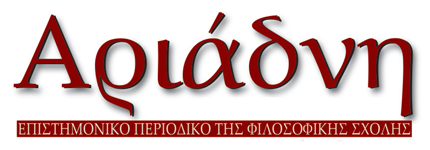Η αφηγηματοποίηση της μεταφοράς των «φώτων» στον Παπατρέχα και τον Λογιώτατο Ταξιδιώτη
DOI:
https://doi.org/10.26248/ariadne.v10i0.998Περίληψη
The first fully developed instance of the light metaphor in texts of the Modern Greek Enlightenment is found in Iosipos Moisiodax's Apologia (1780). Occurrences of the metaphor in question abound during the peak of the Greek Enlightenment but the metaphor is sometimes poorly represented in texts of great ideological importance while in texts of literary importance it has to compete with the Christian-Orthodox, pre-romantic or other discourse that employ the same metaphor in their own terms Adamantios Korais' Ο Papatrechas, published in four sequels from 1811 to 1820, narrativizes the light metaphor in terms of the "enlightenment" of an uneducated priest. The systematic study of individual scenes and sequences of episodes reveals a unique synthesis of light metaphors deriving from classical literature (Homer to Plato), texts of the Greek Orthodox Church and the symbols of the Enlightenment. In his Logiotatos Taxiodiotis Ioannis Vilaras adapts Bernadin de Saint-Pierre's La Chaumiere indienne to the realities of the language controversy in early 19th century Greece. He tells a story that postulates and narrativizes the darkness-light and sleep-awaking contrasts.
Λήψεις
Δημοσίευση
Πώς να δημιουργήσετε Αναφορές
Τεύχος
Ενότητα
Άδεια
Οι εργασίες που δημοσιεύονται στο περιοδικό μπορούν να χρησιμοποιηθούν ελεύθερα για μη-εμπορικούς σκοπούς με την προϋπόθεση ότι γίνεται αναφορά στους συγγραφείς και την πρώτη δημοσίευση. Στην περίπτωση που το άρθρο αλλοιωθεί, τροποποιηθεί ή δημιουργηθεί κάτι νέο βασισμένο στο αρχικό, το έργο που θα προκύψει θα μπορεί να διανεμηθεί μόνο με την ίδια ή παρόμοια άδεια (Creative Commons Attribution-NonCommercial-ShareAlike 4.0 International License).


